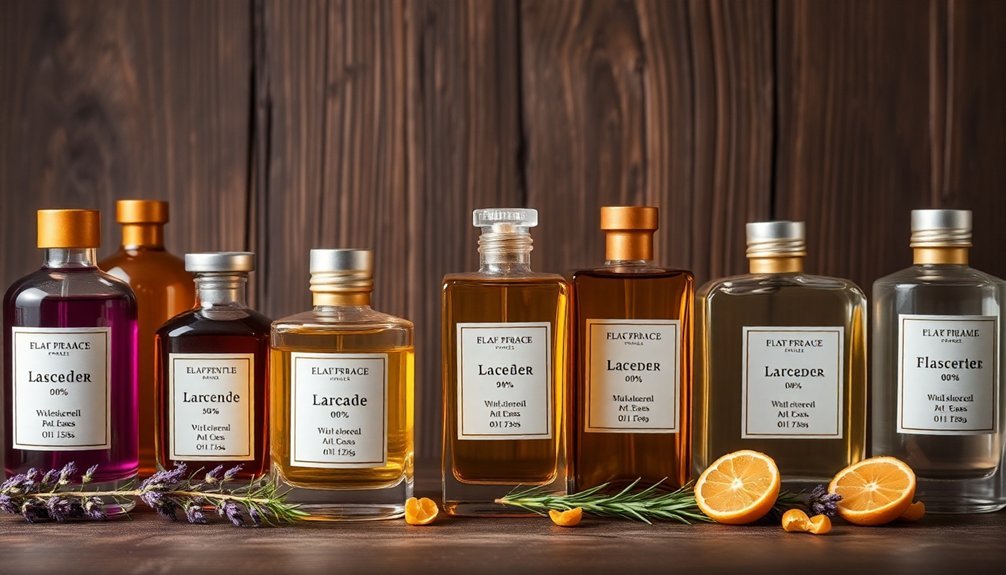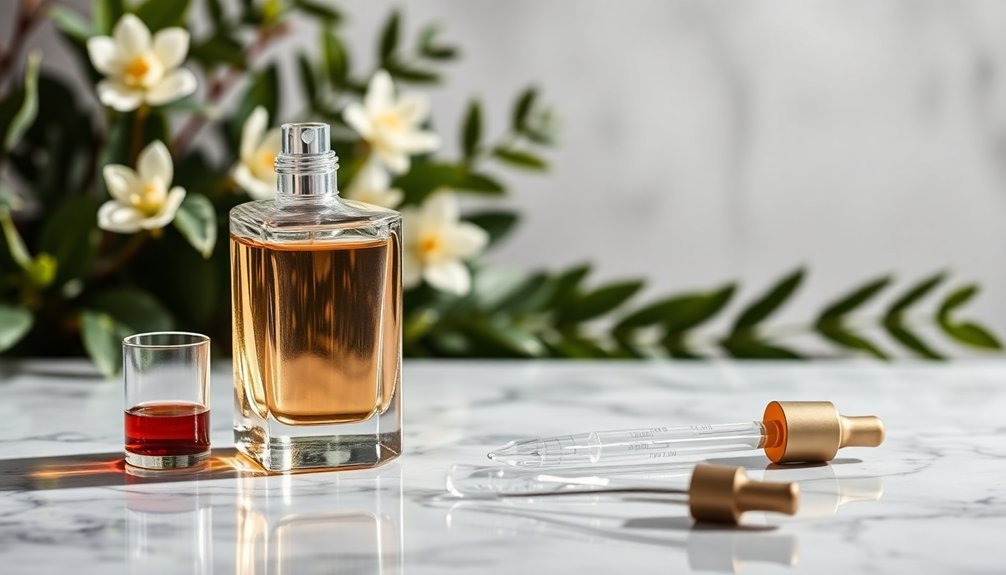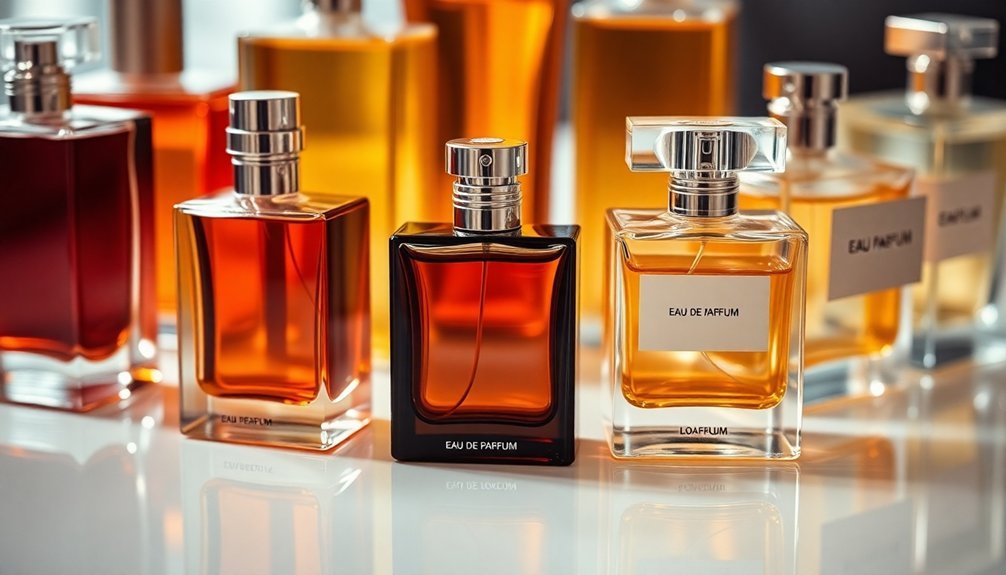Different perfume types contain varying concentrations of fragrance oils that determine their strength and longevity. You'll find Parfum as the strongest at 20-40%, followed by Eau de Parfum at 15-20%, Eau de Toilette at 5-15%, Eau de Cologne at 2-5%, and Eau Fraîche at 1-3%. Each type serves a specific purpose, from light daytime wear to long-lasting evening scents. Understanding these concentrations helps you choose the perfect fragrance intensity for your needs.
Understanding Essential Oil Percentages in Perfumery

When creating perfumes, understanding essential oil percentages is crucial for achieving the right balance and strength.
You'll find that different perfume types require varying concentrations of essential oils to work effectively. Alcohol-based perfumes typically contain 5-25% essential oils, while oil-based versions use 15-30%. If you're working with solid perfumes, you'll need higher concentrations of 25-40%.
The type of carrier also affects how the fragrance performs. Alcohol-based perfumes are more volatile but great for light, invigorating scents. Following the proper base, heart, head order when adding oils ensures optimal blending and fragrance development.
Oil-based formulations offer better skin compatibility and use natural carriers like jojoba or sweet almond oil. Solid perfumes, which often use a wax base, provide the most concentrated and long-lasting fragrance experience, making them ideal for stronger scent profiles.
The Mathematics Behind Perfume Dilution Ratios
To create your signature scent, you'll need to master the basic math of perfume ratios, where essential oils typically range from 10% to 40% depending on the type you're making.
When mixing an Eau de Toilette, you'll combine one part essential oil with nine parts alcohol for a 10% concentration, while an Eau de Parfum requires closer to two parts essential oil with eight parts alcohol for a 20% blend. Just like with cleaning products, you can use the add both numbers technique to calculate your ratios accurately.
Understanding these ratios helps you calculate exact measurements for any size bottle, ensuring consistent fragrance strength whether you're making 30ml or 100ml of perfume.
Calculating Essential Oil Content
Understanding perfume dilution ratios requires a solid grasp of basic mathematical principles and precise measurements.
To calculate essential oil content, you'll need to start with your desired total volume and determine the appropriate concentration percentage for your perfume type.
For example, if you're creating an Eau de Toilette (EDT) with a 10% concentration in a 100ml bottle, you'll need 10ml of essential oils and 90ml of carrier liquid. For stronger formulations like Eau de Parfum (EDP), you'll use 15-20% essential oils.
The X-Pattern calculation method helps you determine precise dilutions based on cost and concentration. With modern fragrance and soap suppliers offering detailed guidelines, you can optimize your formulations for consistency.
Remember to adjust your calculations according to the specific fragrance notes you're using and always guarantee your total percentages equal 100% when combining base, heart, and head notes.
Understanding Alcohol-Oil Ratios
Mastering alcohol-oil ratios forms the foundation of professional perfume creation.
When you're creating perfumes, you'll need to calculate precise measurements of fragrant materials and carriers to achieve your desired concentration. For a 40% dilution in a 10g mixture, you'll use 4g of fragrant material and 6g of alcohol.
To guarantee accuracy, always use a scale rather than counting drops. You'll want to zero your scale between measurements to maintain precision.
Remember that perfumer's alcohol serves as the primary carrier, helping fragrances evaporate and diffuse properly. While it's essential for traditional perfumes, you can't use it in products like candles or creams.
The right ratio not only affects the strength of your scent but also its stability and longevity.
Calculating Perfect Fragrance-to-Carrier Ratios

When creating custom perfumes, achieving the right balance between fragrance oils and carrier agents determines the final product's strength, longevity, and overall quality.
You'll typically start with a base ratio of 80% carrier agents to 20% fragrance oils, but this can vary depending on the type of perfume you're making.
- For a 100ml EDT bottle, you'll need 5-15ml fragrance oils and 85-95ml carrier agents.
- EDP formulations require 15-20ml fragrance oils per 100ml final product.
- Pure parfum uses up to 30ml fragrance oils per 100ml for maximum intensity.
- Aftershave and cologne need only 1-5ml fragrance oils per 100ml.
- Always measure precisely using proper equipment for consistent results.
Remember to add your fragrance oils gradually to the carrier agents, mixing thoroughly to guarantee even distribution and ideal scent development.
Measuring Techniques for Different Perfume Types
You'll need specific measuring tools to accurately determine fragrance concentrations for different perfume types, including laser displacement sensors for volume checks and spectroscopic equipment for chemical analysis.
The standard dilution ratios range from 2-4% for eau de cologne to 15-40% for parfum, requiring precise measurements to maintain consistency.
When measuring, you must follow step-by-step protocols that include testing at pulse points, evaluating at timed intervals, and conducting both sensory and chemical analyses to guarantee quality.
Precision Tools and Methods
Precision lies at the heart of perfume creation and measurement.
You'll find sophisticated tools and methods that guarantee accurate fragrance concentration levels across different perfume types. From spectroscopic analysis to electrical sensing, modern technology helps perfumers maintain consistent quality.
- Spectroscopy tools analyze chemical composition by using light interaction
- Electrosensing devices track olfactory neuron responses to fragrances
- Vapor pressure analyzers determine aroma chemical volatility
- Laser displacement sensors measure liquid levels precisely
- Static pressure sensors calculate filling volumes accurately
When you're working with perfumes, you can use these precision instruments to verify concentration levels.
For example, eau de parfum should contain 15-20% essential oils, while cologne contains just 3-5%. These tools help maintain these exact ratios and guarantee you're getting the fragrance strength you expect.
Dilution Ratio Standards
Understanding dilution ratios forms the foundation of professional perfume creation. When you're working with fragrances, you'll need to know the standard concentrations for each type: Eau de Cologne contains 3-5% fragrant materials, Eau de Toilette has 10%, Eau de Parfum uses 15-20%, and Parfum reaches 20-30%.
You'll find that perfumer's alcohol is the preferred carrier for evaluating scent profiles, while carrier oils work better for aromatherapy applications.
For topical use, you'll want to follow specific safety guidelines: keep essential oils at 5% or less for general use, 1% for facial products, and 2% for massage oils.
These ratios aren't just numbers—they're essential measurements that determine your fragrance's performance, longevity, and safety.
Step-by-Step Measurement Protocols
Building on these dilution standards, mastering specific measurement protocols takes your perfume creation to the next level.
You'll need to conduct precise tests to guarantee your fragrance meets quality benchmarks. Start by spraying the perfume on pulse points and evaluating it after 5 minutes for initial strength. Then, perform persistence tests over 24 hours to determine longevity. Use a fragrance meter for exact strength measurements, and consider room temperature and humidity conditions.
- Test in a scent-free environment to avoid contamination
- Spray on both skin and paper to compare development
- Measure vapor pressure to determine volatility rates
- Use spectroscopic analysis for chemical composition verification
- Conduct electrosensing tests to evaluate neural responses
Blending Formulas for Each Fragrance Category
Creating successful perfume blends begins with mastering the basic formulas for each fragrance category.
You'll want to start with a balanced composition, focusing on the interaction between different fragrance families. For floral blends, combine fresh and soft floral notes as your heart, supported by woody or ambery base notes.
When working with oriental scents, layer vanilla and spice notes over an amber base, adding floral accents for complexity.
For woody fragrances, build around sandalwood or cedar wood bases, incorporating complementary fresh or floral top notes.
Fresh and fruity blends work best with citrus and green notes as top layers, anchored by lighter woody or soft ambery bases.
Remember to follow the fragrance wheel's guidance, placing complementary or contrasting notes together for the most harmonious results.
Key Differences in Concentration Levels

While many people focus on fragrance notes, the concentration level of a perfume largely determines its strength and longevity.
When you're choosing a fragrance, understanding these concentration levels can help you select the perfect scent for your needs and budget.
- Parfum contains the highest concentration at 20-40% oils, lasting up to 24 hours
- Eau de Parfum offers 15-20% concentration with 6-8 hours of wear time
- Eau de Toilette provides 5-15% concentration, perfect for 3-4 hours of daytime wear
- Eau de Cologne features 2-5% oils, lasting about 2 hours
- Eau Fraîche has the lightest concentration at 1-3%, with a revitalizing 2-hour duration
These varying concentrations also affect the price, with higher concentrations typically commanding premium prices due to their increased oil content.
Tools and Methods for Precise Measurements
To achieve accuracy in perfume creation and analysis, professionals rely on several sophisticated measurement tools and techniques. You'll find various methods used in the industry to guarantee precise measurements of fragrance concentrations.
The volume measurement method lets you calculate the perfume content by determining total mass and subtracting the container's weight.
If you're looking for continuous monitoring, static pressure sensors at the bottle's bottom can measure liquid levels through pressure detection. For direct measurements, you can use laser displacement sensors mounted above the bottle, which work effectively even with opaque containers.
Additionally, you'll encounter specialized liquid volume sensors that use techniques like U-tube oscillation or buoyancy methods.
These tools help determine density and mass with exceptional accuracy, guaranteeing the right concentration for each perfume type.
Master Recipe Ratios for Six Perfume Types

Now that we comprehend how to measure perfume components accurately, let's explore the specific ratios that define each perfume type.
The strongest concentration is parfum, containing 20-40% fragrance oils diluted in alcohol or carrier oil. Eau de parfum follows with 15-20% oils, while eau de toilette contains 5-15%. The lightest concentration is eau de cologne at 2-5% oils.
- Parfum's high concentration makes it ideal for special occasions and evening wear
- Eau de parfum offers the perfect balance between longevity and everyday use
- Eau de toilette works well for subtle, daytime fragrances
- Eau de cologne provides a light, invigorating option for casual wear
- Higher oil concentrations result in longer-lasting scents and fewer reapplications
These ratios directly impact how long you'll enjoy your fragrance and how often you'll need to reapply it.
Common Dilution Mistakes to Avoid
Since creating the perfect fragrance requires precise dilution, understanding common mistakes can save you time and precious materials.
You'll want to avoid using arbitrary dilution percentages that don't account for each material's potency. Always measure ingredients by weight, not drops, and use a reliable scale for accuracy.
Don't make the mistake of storing your fragrances improperly or applying them to dry skin. Keep them in a cool, dark place and moisturize before application.
When experimenting, avoid using the same dilution ratio for all materials, as this can waste strong ingredients and diminish the effectiveness of weaker ones.
Pay attention to material compatibility and avoid mixing scents that clash. Remember to test your fragrances at different concentrations to understand how they perform over time.
Frequently Asked Questions
Why Do Some Perfumes Smell Different on Different People?
Your unique body chemistry, including hormones, skin oils, and sweat, interacts differently with fragrance molecules. Your diet, skin type, and environment also affect how perfumes smell when they're on your skin.
How Does Temperature Affect the Concentration of Essential Oils?
You'll find that high temperatures above 100°F damage your essential oils, reducing their effectiveness and altering their scent. They'll lose volatile compounds, while cooler temperatures help preserve their quality and therapeutic properties.
Can I Convert My EDT Into an EDP by Adding Oils?
You shouldn't convert EDT to EDP by adding oils. It'll disrupt the fragrance's carefully balanced formula, potentially ruining the scent and stability. It's better to purchase an EDP version or create a new formulation.
Why Do Natural Perfumes Often Cost More Than Synthetic Ones?
You'll find natural perfumes cost more because they require labor-intensive extraction, use rare ingredients, and yield small amounts. For example, it takes 10,000 roses to make just one gram of rose oil.
Does Layering Different Perfume Types Increase Their Lasting Power?
Yes, layering perfumes can extend lasting power. When you layer correctly, starting with lighter fragrances and ending with heavier ones, you'll create a more complex scent that lasts longer throughout the day.
In Summary
You've now learned the standard concentration ratios for each perfume type: Parfum (20-30%), Eau de Parfum (15-20%), Eau de Toilette (5-15%), Eau de Cologne (2-4%), and Body Splash (1-3%). Whether you're creating your own fragrances or shopping for the perfect scent, understanding these percentages helps you make informed decisions about longevity, strength, and value. Remember to measure precisely and adjust ratios based on your specific fragrance oils.





Leave a Reply